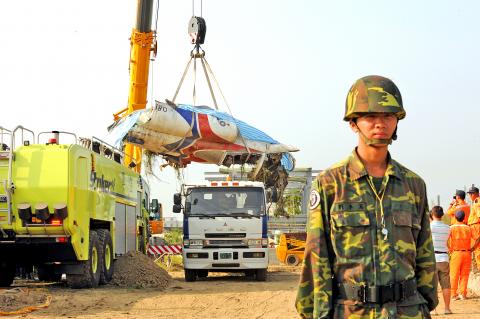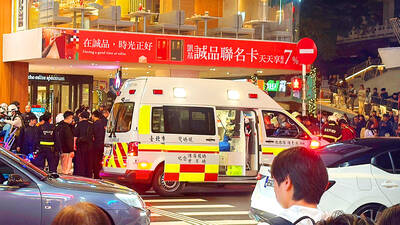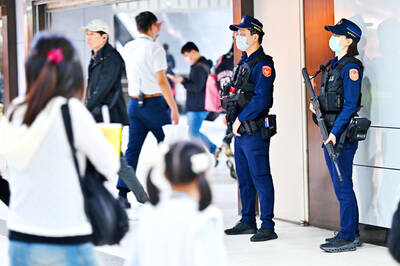The pilot of a 37-year-old AT-3 training aircraft belonging to the Air Force Academy died yesterday after his aircraft collided with another AT-3 and crashed during a routine training mission of the Thunder Tiger Aerobatics Team in Greater Kaohsiung, military officials said.
The pilot, Lieutenant Colonel Chuang Pei-yuan (莊倍源), tried to parachute to safety before the plane crashed in a field in Greater Kaohsiung’s Zihguan District (梓官), but he ejected from the plane at too low an altitude and his parachute never fully opened, the air force said.
Chuang sustained serious injuries after falling to the ground and was rushed to the Gangshan Branch of the Armed Forces Kaohsiung General Hospital, the Ministry of National Defense said.

Photo: Chang Chung-i, Taipei Times
Doctors at the hospital tried to revive the 37-year-old, but to no avail, it added.
The crash occurred at about 11:17am yesterday after Chuang’s jet collided with another AT-3 flown by Lieutenant Colonel Yang Chih-ping (楊志平), which was not badly damaged and landed safely at the Air Force Academy in Greater Kaohsiung.
In video clips obtained by the Chinese-langauge Liberty Times (the Taipei Times’ sister paper) and posted on its Web site shortly after noon yesterday, three AT-3s are seen flying in formation at high velocity and trailing white smoke.
Chuang’s AT-3 then accidentally clips another aircraft in a cross-over run. It first climbs higher, but begins to spin out of control and heads toward the ground at an incline.
Another video showed the two AT-3 planes make contact in mid-air, with the leading plane’s tail breaking off, then flying erratically before crashing.
The sounds of nearby bystander witnesses were also recorded, shouting: “There is a collision, the plane is going to crash,” “Oh, no, it’s going out of control” and “Get out quick, jump out with the parachute.”
Both Chuang and Yang are senior pilots who have clocked more than 2,000 flight hours, Air Force Academy superintendent Chang Yan-ting (張延廷) said at a news conference.
The two had been partners for about two years and participated in the formation of seven AT-3 jet trainers flown by the Thunder Tiger Aerobatics Team that streaked over the Presidential Office as part of Double Ten National Day celebrations on Oct. 10 this year, Chang said.
The Air Force Command Headquarters has set up a task force to probe the cause of the crash. There have been 12 crashes involving AT-3 training aircraft since 1990, resulting in the death of seven pilots.
An air force official said that Chuang missed the opportunity to eject from his aircraft at a higher altitude because he was trying to maneuver his aircraft clear of residential communities and crowds.
Chuang would have been able to save his life if he had bailed from the aircraft earlier, the official said, but he did not want to endanger the lives of others.
“This showed the pilot’s great virtue,” the official said.
Following the crash yesterday, legislators asked the Ministry of National Defense about plans to phase out the aging AT-3 aircraft, which have been in service for more than 25 years.

TRAGEDY STRIKES TAIPEI: The suspect died after falling off a building after he threw smoke grenades into Taipei Main Station and went on a killing spree in Zhongshan A 27-year-old suspect allegedly threw smoke grenades in Taipei Main Station and then proceeded to Zhongshan MRT Station in a random killing spree that resulted in the death of the suspect and two other civilians, and seven injured, including one in critical condition, as of press time last night. The suspect, identified as a man surnamed Chang Wen (張文), allegedly began the attack at Taipei Main Station, the Taipei Fire Department said, adding that it received a report at 5:24pm that smoke grenades had been thrown in the station. One man in his 50s was rushed to hospital after a cardiac arrest

SAFETY FIRST: Double the number of police were deployed at the Taipei Marathon, while other cities released plans to bolster public event safety Authorities across Taiwan have stepped up security measures ahead of Christmas and New Year events, following a knife and smoke bomb attack in Taipei on Friday that left four people dead and 11 injured. In a bid to prevent potential copycat incidents, police deployments have been expanded for large gatherings, transport hubs, and other crowded public spaces, according to official statements from police and city authorities. Taipei Mayor Chiang Wan-an (蔣萬安) said the city has “comprehensively raised security readiness” in crowded areas, increased police deployments with armed officers, and intensified patrols during weekends and nighttime hours. For large-scale events, security checkpoints and explosives

A car bomb killed a senior Russian general in southern Moscow yesterday morning, the latest high-profile army figure to be blown up in a blast that came just hours after Russian and Ukrainian delegates held separate talks in Miami on a plan to end the war. Kyiv has not commented on the incident, but Russian investigators said they were probing whether the blast was “linked” to “Ukrainian special forces.” The attack was similar to other assassinations of generals and pro-war figures that have either been claimed, or are widely believed to have been orchestrated, by Ukraine. Russian Lieutenant General Fanil Sarvarov, 56, head

PUBLIC SAFETY: The premier said that security would be tightened in transport hubs, while President Lai commended the public for their bravery The government is to deploy more police, including rapid response units, in crowded public areas to ensure a swift response to any threats, President William Lai (賴清德) said yesterday after a knife attack killed three people and injured 11 in Taipei the previous day. Lai made the remarks following a briefing by the National Police Agency on the progress of the investigation, saying that the attack underscored the importance of cooperation in public security between the central and local governments. The attack unfolded in the early evening on Friday around Taipei Main Station’s M7 exit and later near the Taipei MRT’s Zhongshan